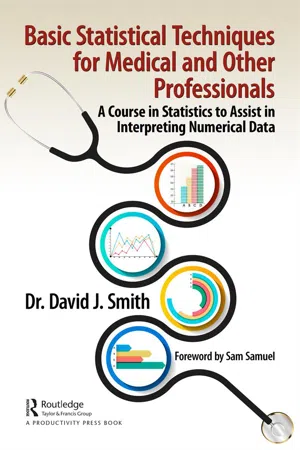
Basic Statistical Techniques for Medical and Other Professionals
A Course in Statistics to Assist in Interpreting Numerical Data
- 116 pages
- English
- ePUB (mobile friendly)
- Available on iOS & Android
Basic Statistical Techniques for Medical and Other Professionals
A Course in Statistics to Assist in Interpreting Numerical Data
About this book
We are bombarded with statistical data each and every day, and healthcare professionals are no exception. All sectors of healthcare rely on data provided by insurance companies, consultants, research firms, and government to help them make a host of decisions regarding the delivery of medical services. But while these health professionals rely on data, do they really make the best use of the information? Not if they fail to understand whether the assumptions behind the formulas generating the numbers make sense. Not if they don't understand that the world of healthcare is flooded with inaccurate, misleading, and even dangerous statistics. The purpose of this book is to provide members of medical and other professions, including scientists and engineers, with a basic understanding of statistics and probability together with an explanation and worked examples of the techniques. It does not seek to confuse the reader with in-depth mathematics but provides basic methods for interpreting data and making inferences. The worked examples are medically based, but the principles apply to the analysis of any numerical data.
Frequently asked questions
- Essential is ideal for learners and professionals who enjoy exploring a wide range of subjects. Access the Essential Library with 800,000+ trusted titles and best-sellers across business, personal growth, and the humanities. Includes unlimited reading time and Standard Read Aloud voice.
- Complete: Perfect for advanced learners and researchers needing full, unrestricted access. Unlock 1.4M+ books across hundreds of subjects, including academic and specialized titles. The Complete Plan also includes advanced features like Premium Read Aloud and Research Assistant.
Please note we cannot support devices running on iOS 13 and Android 7 or earlier. Learn more about using the app.
Information
Chapter 1
Why One Needs Statistical Techniques
7.5, 7.2, 8, 6, 5.6, 5, 7, 5.5, 5, 5.5

An average (we use the word MEAN in statistical work)andProviding a visual plot of the trend (a linear GRAPH)
Variables and Attributes
Spread of a Variable
Correlation
Taking Samples
Very Large and Very Small Numbers
Chapter 2
Probability and Its Rules
Empirical versus À Priori
Table of contents
- Cover
- Half Title
- Title Page
- Copyright Page
- Contents
- Foreword
- Preface
- Acknowledgments
- About the Author
- Introduction
- 1 Why One Needs Statistical Techniques
- 2 Probability and Its Rules
- 3 Dealing with Variables
- 4 Comparing Variables
- 5 Presenting Data and Establishing Trends
- 6 Dealing with Attributes
- 7 Testing for Significance (Attributes)
- 8 Correlation and Regression
- 9 Handling Numbers (Large and Small)
- 10 An Introduction to Risk
- 11 A Final Word
- Appendices
- Index